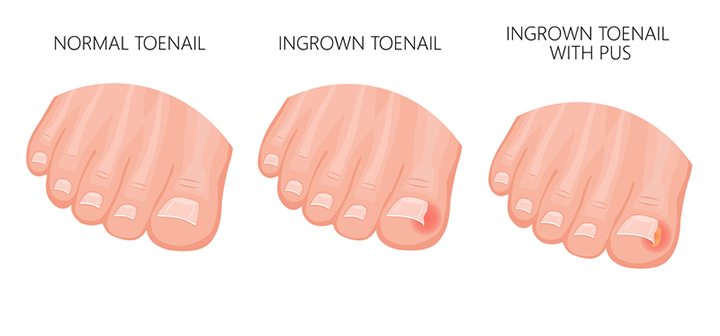What to Know About Ingrown Toenails: Causes, Symptoms, Treatment & Prevention
Don’t take another painful step! Here’s what to do if you have you have an ingrown toenail—and how to prevent it from coming back.
If you’ve ever had an ingrown toenail, that stabbing—and almost unbearable—pain and pressure is probably hard to forget. (Who knew that one tiny toenail could cause that much trouble?) An ingrown toenail occurs when the corner or sides of the nail dig into the skin. If the nail manages to break the skin, more intense pain—and possibly infection—will follow.
According to the U.S. National Library of Medicine, 20 out of 100 people who visit the doctor due to a foot problem have an ingrown toenail. So what causes ingrown toenails, and how are they treated? Let’s take a closer look.
Causes of Ingrown Toenails
The following are the most common causes of ingrown toenails:
- Poorly fitted shoes
- Improperly trimmed toenails
- Repeated activities affecting the toes, like playing soccer or running
- Toe injury
- Naturally curved toenails
- Sweaty feet
- Obesity
Ingrown toenails are common in teenagers and young adults because they tend to sweat more, but they’re also common in the elderly because of a decreasing ability to take care of their feet and toenails on a regular basis due to physical limitations and thicker nails. The elderly are also at a higher risk of diabetes, which can negatively affect foot health.
Symptoms of an Ingrown Toenail
If you experience any of the following symptoms, you most likely have an ingrown toenail:
- Pain and tenderness
- Swelling
- Redness
- Pus draining from the affected area
- Odor coming from the affected area
When examining ingrown toenails, doctors typically distinguish the severity of the condition by three stages:
- Stage 1: The skin on the side of the toe is painful and inflamed due to the nail growing into it.
- Stage 2: New, inflamed tissue has grown at the edges of the toenail and is producing discharge.
- Stage 3: The skin around the nail is chronically inflamed and oozing pus. The new tissue continues to grow over the nail.

Ingrown toenails most commonly occur in the the “big” toe. Those with “big” toes that are shorter than the second toes are even more prone to ingrown toenails. However, any toenail can be affected on either side. Photo courtesy of © Aksana Kulchytskaya | Dreamstime.com
At-Home Treatment
If you happen to notice your ingrown toenail while it’s in stage 1, you may be able to treat it at home. The American Academy of Orthopaedic Surgeons recommends taking the following steps:
- Soak your foot in warm water three to four times a day.
- Wear shoes with a wide toe box or sandals until your toe has healed.
- Take an OTC medication to relieve pain and reduce inflammation.
- If possible, gently lift the ingrown toenail and insert a small piece of cotton between your nail and your skin. Change the cotton every day.
Don’t try to cut the ingrown toenail down yourself, since repeated cutting of the nail could make the condition worse. If you don’t notice any improvement after two to three days of treatment at home, or if you notice any discharge or odor coming from the affected toe, then it’s time to call your podiatrist.
Treatment is especially important if you’re diabetic or you have any condition that causes poor blood flow or infection in your feet. If left untreated, ingrown toenails that are infected can lead to a bone infection, foot ulcers, or gangrene.
When to See a Doctor for an Ingrown Toenail
If your ingrown toenail becomes infected and/or extremely painful, your doctor may recommend surgery to partially or completely remove the nail.
After applying a local anesthetic, your doctor will use scissors to remove the ingrown part of the nail in a procedure called nail ablation. And if there’s a risk that the nail may become ingrown again, the doctor may decide to perform a partial or whole nail avulsion instead to prevent regrowth of the nail. Following the procedure, a light bandage is applied, and most patients can resume normal activities the next day. If skin around the nail is infected, you may be instructed to take oral antibiotics following surgery.
Ingrown Toenail Prevention
To prevent a recurring ingrown toenail issue, it’s important to follow these steps:
- Keep your feet clean and dry at all times.
- Cut your toenails in a straight line, but not too short. Also, don’t taper or round the corners. Your fingernail should be able to get under the sides and end of your toenails.
- Wear shoes and socks that fit properly. They shouldn’t be too tight, loose, or short.
RECOMMENDED FOR YOU


 Safety of Silicone Bakeware?
Safety of Silicone Bakeware?  Personal Beliefs About Drugs Influence Brain Activity
Personal Beliefs About Drugs Influence Brain Activity  MGH Study: Hot Yoga May Help Ease Depression Symptoms, but Be Mindful of Health Concerns
MGH Study: Hot Yoga May Help Ease Depression Symptoms, but Be Mindful of Health Concerns 
If you happen to notice your ingrown toenail while it’s in stage 1, you may be able to treat it at home.
© Winai Tepsuttinun | Dreamstime.com